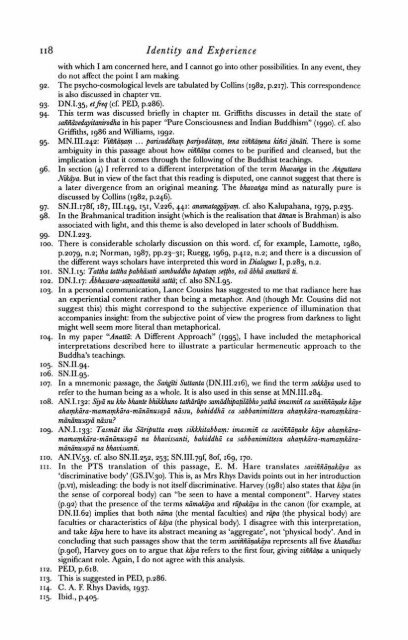Identity and Experience_Hamilton_1996
Identity and Experience_Hamilton_1996
Identity and Experience_Hamilton_1996
You also want an ePaper? Increase the reach of your titles
YUMPU automatically turns print PDFs into web optimized ePapers that Google loves.
I 18<br />
<strong>Identity</strong> <strong>and</strong> <strong>Experience</strong><br />
with which I am concerned here, <strong>and</strong> I cannot go into other possibilities. In any event, they<br />
do not affect the point I am making.<br />
92. The psycho-cosmological levels are tabulated by Collins (1982, p.217). This correspondence<br />
is also discussed in chapter VII.<br />
93. DN. 1-35, etfiq (cf. PED, p.286).<br />
94. This term was discussed briefly in chapter 111. Griffiths discusses in detail the state of<br />
safifiivedqitanirodha in his paper "Pure Consciousness <strong>and</strong> Indian Buddhism" (1990). cf. also<br />
Griffiths, 1986 <strong>and</strong> Williams, 1992.<br />
95. MN.III.242: VSfiipzm . . . pakuddham pariyoditam, tena vififiiiqena kifici jiniti. There is some<br />
ambiguity in this passage about how uifiE&za comes to be purified <strong>and</strong> cleansed, but the<br />
implication is that it comes through the following of the Buddhist teachings.<br />
96. In section (4) I referred to a different interpretation of the term bhavatiga in the Ariguttura<br />
JVikaya. But in view of the fact that this reading is disputed, one cannot suggest that there is<br />
a later divergence from an original meaning. The bhavanga mind as naturally pure is<br />
discussed by Collins (1982, p.246).<br />
97. SN.11.178f; 187,III.149, 151, V.226, 441: anamatugLiyam. cf: also Kalupahana, 1979, p.235.<br />
98. In the Brahmanical tradition insight (which is the realisation that itman is Brahman) is also<br />
associated with light, <strong>and</strong> this theme is also developed in later schools of Buddhism.<br />
99. DN.I.ZZ~.<br />
loo. There is considerable scholarly discussion on this word. cf, for example, Lamotte, 1980,<br />
p.2079, n.2; Norman, 1987, pp.23-31; Ruegg, 1969, p.412, n.2; <strong>and</strong> there is a discussion of<br />
the different ways scholars have interpreted this word in Dialogues I, p.283, n.2.<br />
I or. sN.1.15: Tattha tuttha pabhisati sambuddho tapatam settho, esi ibhi anuttari ti.<br />
102. DN.I.17: Abhara-samvattaniki sattii; cE also SN.I.95.<br />
103. In a personal communication, Lance Cousins has suggested to me that radiance here has<br />
an experiential content rather than being a metaphor. And (though Mr. Cousins did not<br />
suggest this) this might correspond to the subjective experience of illumination that<br />
accompanies insight: from the subjective point of view the progress from darkness to light<br />
might well seem more literal than metaphorical.<br />
104. In my paper "Anatti: A Different Approach" (1gg5), I have included the metaphorical<br />
interpretations described here to illustrate a particular hermeneutic approach to the<br />
Buddha's teachings.<br />
105. SN.II.94.<br />
106. SN.II.95.<br />
107. In a mnemonic passage, the S aw' Suttanta (DN.111.216)~ we find the term sahya used to<br />
refer to the human being as a whole. It is also used in this sense at MN.III.284.<br />
I 08. AN.1.132: S+i nu kho bhank bhikkhuno tathiripo samiidhipatiliibhoyathii imasmifi ca savififiiivke k9e<br />
ahamkira-mamamkiira-miininusayi nissu, bahiddhii ca sabbanimittesu ahamkira-mamamkiiramcininusayi<br />
nsu?<br />
109. AN.1.133: Tasmiit iha Siriputta evam sikkhitabbam: imasmifi ca savififiipzke kiiye ahamkiramamamkira-miniinusayii<br />
na bhavissanti, bahiddhii ca sabbanimittesu ahamkira-mamamkaramininusayti<br />
na bhavtsfanti.<br />
110. AN.IV.53. cf. also SN.II.252, 253; SN.III.7gC 8of, 169, 170.<br />
1x1. In the PTS translation of this passage, E. M. Hare translates savififiinakiiya as<br />
'discriminative body' (GS.IV3o). This is, as Mrs Rhys Davids points out in her introduction<br />
(p.v~), misleading: the body is not itself discriminative. Harvey.(1g81) also states that fiya (in<br />
the sense of corporeal body) can "be seen to have a mental component". Harvey states<br />
(p.92) that the presence of the terms niImaka3a <strong>and</strong> ripakrSya in the canon (for example, at<br />
DN.II.62) implies that both nima (the mental faculties) <strong>and</strong> nSpa (the physical body) are<br />
faculties or characteristics of kiya (the physical body). I disagree with this interpretation,<br />
<strong>and</strong> take kLiya here to have its abstract meaning as 'aggregate', not 'physical body'. And in<br />
concluding that such passages show that the term savifiEE&*a represents all five kh<strong>and</strong>hus<br />
(p.gof), Harvey goes on to argue that kqa refers to the first four, giving vififiipz a uniquely<br />
significant role. Again, I do not agree with this analysis.<br />
112. PED, p.618.<br />
1x3. This is suggested in PED, p.286.<br />
1x4. C. A. E Rhys Davids, 1937.<br />
1x5. Ibid., p.405.


